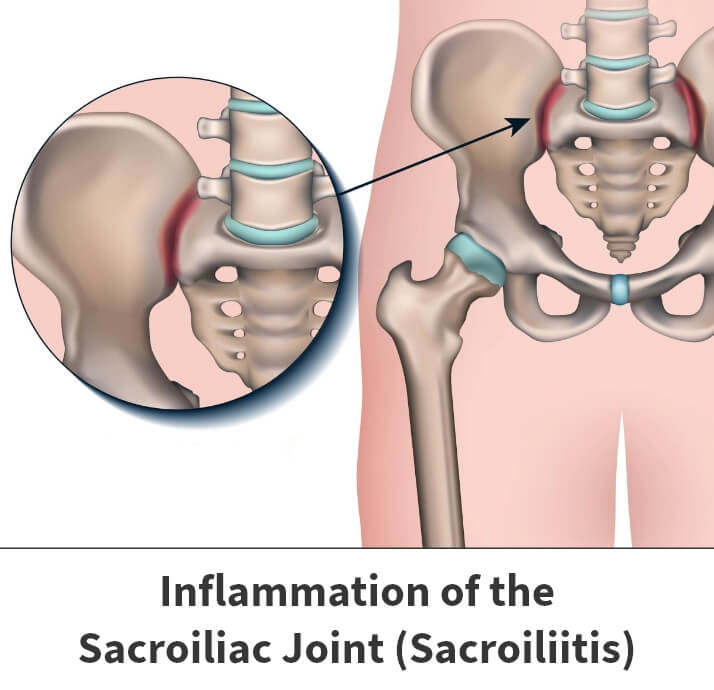Sacroiliac joint pain
The back is one of the body’s most essential parts. It supports your body’s weight, connects other structures, and allows you to perform basic exercises.
When the back or any of its components undergo an injury, you can experience pain and other life-altering symptoms. One of these issues is sacroiliac joint pain.
Anatomy

The sacroiliac joints connect several bones to the spine, hip, and other lower body areas. These joints help support your body weight and absorb the pressure on the spine.
About
Bones surrounding the sacroiliac joints are uneven. These jagged edges help keep surrounding bones and other parts together. Also, the spaces near these bones are covered by nerve endings, which send pain signals to the brain.
When joints, neighboring bones, muscles, or tissues are injured or diseased, pain and other symptoms can develop. This condition is known as sacroiliac joint dysfunction or sacroiliitis.
Causes
Several factors can cause sacroiliac joint inflammation, including medical conditions, pregnancy, improper walking habits, and acute injury.
Certain medical conditions can cause this condition, such as:
- Osteoarthritis (when neighboring soft tissues like cartilage grow weakened)
- Gout (where large levels of an irritating substance called uric acid collect inside joints)
- Ankylosing spondylitis (when the spine’s vertebrae are damaged)
A woman’s body releases a hormone enabling joints to stretch more than usual during pregnancy. This process can result in sacroiliac joint pain and injury. Additionally, associated weight gain places extra pressure on the back and surrounding parts.
People may walk incorrectly for various reasons. This places unnecessary pressure on the back, resulting in sacroiliac joint pain.
The intense pressure created by car accidents or falls from long distances can lead to sacroiliac joint pain and damage.
Risk factors
An individual’s chances of experiencing sacroiliac joint injury and pain increase if they are:
- Significantly overweight or obese
- Pregnant
- Using improper walking patterns
- Participating in a recreational activity or profession that places great strain on their backs
- A pre-existing back or spinal injury
Those who have undergone back or spinal surgery might be at greater risk. Also, having one leg that is noticeably shorter than the other could lead to the issue.

Symptoms
Each case can be different, and people might not always encounter the same symptoms. But the most common symptom is pain. This discomfort often appears in the lower back, spreads to regions like the buttocks, hip, groin, and pelvis, and intensifies while standing or performing various activities. Additional symptoms include:
- A stiffness or burning sensation
- Weakness
- Numbness
- The feeling like one’s legs will collapse under their body weight
More severe cases can result in major mobility limitations.
Complications
When left untreated, sacroiliac joint problems can lead to pain that interferes with everyday activities, interrupts sleep, and could eventually cause severe mobility concerns.
Diagnosis
Diagnosing a sacroiliac joint issue is not always straightforward. Since the joint is located deep inside the body, reaching a firm diagnosis often requires doctors to use several diagnostic techniques. Joint issues do not always appear clearly on internal imaging tests and often mimic other conditions.
Doctors may use other tools, such as requesting that the patient perform various stretching exercises or injecting numbing agents into the sacroiliac joint. If the pain decreases, it’s most likely that the patient is dealing with joint inflammation.
Treatment
Many cases of mild to moderate sacroiliac joint pain respond to non-surgical treatments. So, surgery is only used in severe instances or when less aggressive therapies have proven unsuccessful.
Nonsurgical treatments
- Heat and cold application – Mild injuries can benefit from applying hot and cold temperatures. This can be done using ice packs, heating pads, or bathing in warm or cold water.
- Low-impact exercises – Occasionally, mild exercise can produce positive outcomes. For example, yoga, stretching, and walking may relieve some stress.
- Medications – Over-the-counter muscle-relaxing, pain-relieving, or inflammation-reducing drugs may lessen symptoms. In more serious instances, prescription steroids may help.
Nonsurgical options
Procedures like radiofrequency ablation (where energy is used to deaden pain-causing nerves) have seen success.
Sacroiliac joint steroid injections can relieve pain caused by arthritis in the sacroiliac joint where the spine and hip bone meet. The steroid medication can reduce swelling and inflammation in the joint.
Surgical intervention
The most severe cases might need an operation known as sacroiliac joint fusion surgery. During this procedure, surgeons insert small metal screws or plates into neighboring bones. This process enables the bones to eventually attach to the sacroiliac joints together to strengthen them.
Outlook
In most cases, the pain and other symptoms associated with sacroiliac joint problems can be controlled or even eliminated with the proper treatment. Many people can make a full recovery.
The length of time needed to recover will vary and depend on factors such as:
- The patient’s age
- Physical conditioning/general health
- The joint damage’s severity
- The method of therapy used to treat the condition
Preventing sacroiliac joint pain
Some accidents and injuries cannot be avoided. But you can reduce your risk by maintaining a healthy weight, exercising, and adopting proper posture and walking habits.
Videos
Related specialties
- Anterior Cervical Corpectomy & Discectomy
- Artificial Disc Replacement (ADR)
- Bone Cement Injection
- Degenerative Disc Disease
- Diffuse Idiopathic Skeletal Hyperostosis (DISH)
- Discectomy
- Discitis Treatment & Information
- Epidural Injections for Spinal Pain
- Foraminotomy
- Interlaminar Implants
- Interlaminar Lumbar Instrumental Fusion: ILIF
- Kyphoplasty (Balloon Vertebroplasty)
- Kyphosis
- Laminectomy: Decompression Surgery
- Lumbar Epidural Steroid Injection
- Lumbar Interbody Fusion (IBF)
- Minimally Invasive Spine Surgery
- Outpatient Spine Surgery
- Pinched Nerve
- Piriformis Syndrome
- Sciatica
- Scoliosis
- Spinal Fusion
- Spondylolisthesis & Spondylolysis
- Vertebroplasty
- Whiplash & Whiplash Associated Disorder (WAD)
